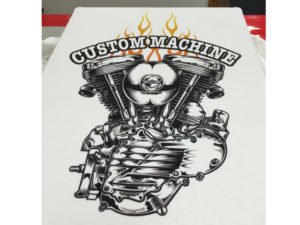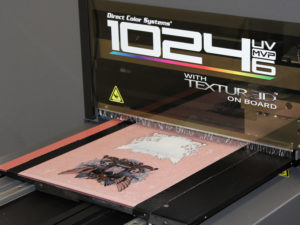
Colin Marsh, managing director of Resolute DTG, takes a look at how sublimation printing is getting in on the DTG process.
As technology regularly leaves its mark on the DTG process the next breakthrough is about to hit the market. Medium format flat bed sublimation printing is now being developed for use with the direct to garment printing process.
Traditionally sublimation textile printing has been transfer based and restricted to small A4 and A3 printers using sublimation inks. On the larger scale at 42in and above reel to reel sublimation printing is used for flat fabric and decorating panels ready to be made into finished products.
The benefits
The benefits of direct to garment printing using sublimation inks is only apparent when using one of the new breed of three axis printers currently appearing in the textile market. All over printing is very popular for sports wear and inherently polyester based fabric which is of course the key to successful sublimation printing. Advances in sublimation ink which allow for direct to garment printing to be successful are a very different formulation to the standard sublimation inks. These still offer the same bright vibrant colours that we are all used to seeing coupled with bomb proof durability in the wash. As these multi function medium format flat bed printers appear throughout 2016 from various manufacturers this allows for the multi process printer to take over.
One printer does it all is now upon us
Medium format multi function printers designed from the ground up, such as the Freestyler computer to screen system being launched by EXILE Technologies at Printwear & Promotion LIVE! are allowing the textile industry to develop in areas that in the past have been cost prohibitive. It is now possible for a medium format flat bed printer to be configured in no more than a couple of minutes to produce a completely different product. A perfect example of this is the direct to garment sublimation process that in minutes switches to producing traditional sublimation transfers but on a much larger scale than the normal A4 and A3 sheet fed printers currently available. With print areas starting at 500x600x150mm depth this jump in technology is set to offer improvements in speed and quality while at the same time reducing ink costs.

What about the maintenance
In many cases built-in self diagnostic software will offer for the first time a machine that can actually tell the operator what the error or part in question is in plain English. This is set to make down time and service costs a thing of the past. This technology is normally used in high end digital presses where in house engineers are trained to change consumable parts rather than waiting for a dedicated engineer to attend. Removing the complexity and introducing this kind of device into the textile industry is a huge step forward, this will allow for many decoration processes to be produced in not only a smaller area but with a much lower buy in cost when utilising the same chassis for multiple printing processes.
Why use a flat bed?
The capability to print anything from a flat piece of transfer paper or fabric to the packaging box it is shipped in using the same device is a very cost effective method. This allows a business to produce more of its products in house saving time and money with a device that is simple to maintain. This almost sounds too good to be true, but it is true and these multi function flat bed devices will have a large presence at Printwear & Promotion LIVE! and many other shows throughout 2016 and beyond.
Plastisol transfers with variable data?
Heat seal transfers produced using traditional screen printing are a popular product. But the process is limited to long runs as setup costs can be quite high for multi coloured designs. A recent development with UV technology soon to be launched allows for a heat seal variable data transfer to be produced with no setup costs. Including white ink and a very flexible durable image with a soft hand this new process will possibly skip Printwear & Promotion LIVE! but is sure to appear at shows across the globe later in the year. Allowing the decoration of everything you can do with a traditional plastisol transfer but with the added benefit of short runs with no setup costs and variable data this is one hot new product to keep an eye out for.
 Printwear & Promotion The Total Promotional Package
Printwear & Promotion The Total Promotional Package




